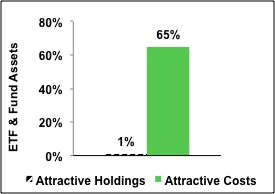Fund holdings affect fund performance more than fees or past performance. A cheap fund is not necessarily a good fund. A fund that has done well in the past is not likely to do well in the future (e.g. 5-star kiss of death and active management has long history of underperformance). Yet, traditional fund research focuses only on low fees and past performance.
Our research on holdings enables investors to find funds with high quality holdings – AND – low fees.
Investors are good at picking cheap funds. We want them to be better at picking funds with good stocks. Both are required to maximize success. We make this easy with our predictive fund ratings. A fund’s predictive rating is based on its holdings and its total costs, and how it ranks when compared to the rest of the 7000+ ETFs and mutual funds we cover.
Figure 1 shows that 65% of fund assets are in ETFs and mutual funds with low costs but only 1% of assets are in ETFs and mutual funds with Attractive holdings. This discrepancy is astounding.
Figure 1: Allocation of Fund Assets By Holdings Quality and By Costs
 Sources: New Constructs, LLC and company filings
Sources: New Constructs, LLC and company filings
Two key shortcomings in the ETF and mutual fund industry cause this large discrepancy:
- A lack of research into the quality of holdings.
- Not enough research focuses on the quality of Portfolio Management of funds
- A lack of high-quality holdings or good stocks.
- With about twice as many funds as stocks in the market, there simply are not enough good stocks to fill all the funds.
These shortcomings are related. If investors had more insight into the quality of funds’ holdings, I think they would allocate a lot less money to funds with poor quality holdings. Many funds would cease to exist.
Investors deserve research on the quality of stocks held by ETFs and mutual funds.
Quality of holdings is the single most important factor in determining an ETF or mutual fund’s future performance. No matter how low the costs, if the ETF or mutual fund holds bad stocks, performance will be poor. Costs are easy to find but research on the quality of holdings is almost non-existent.
Figure 2 shows investors are not putting enough money into ETFs and mutual funds with high-quality holdings. Only 49 of 7267 (1% of assets) ETFs and mutual funds allocate a significant amount of value to quality holdings. 99% of assets are in funds that do not justify their costs and over charge investors for poor portfolio management.
Figure 2: Distribution of ETFs & Mutual Funds (Count & Assets) By Portfolio Management Rating
 Source: New Constructs, LLC and company filings
Source: New Constructs, LLC and company filings
Figure 3 shows that investors successfully find cheap funds. 65% of assets are held in ETFs and mutual funds that have Attractive-or-better rated Total Annual Costs, my apples-to-apples measure of the all-in cost of investing in any given fund.
Out of the 7267 ETFs and mutual funds I cover, 1428 (65% of all assets) earn an Attractive-or-better Total Annual Costs rating.
Clearly, ETF and mutual funds investors are smart shoppers when it comes to finding cheap investments. But cheap is not necessarily good.
Fidelity MSCI Utilities Index ETF (FUTY) is one of many funds with low costs but a Very Dangerous Portfolio Management rating. It gets an overall predictive rating of Very Dangerous because no matter how low its fees, I expect it to underperform because it holds too many (78%) Dangerous-or-worse rated stocks. Low fees cannot boost fund performance. Only good stocks can boost performance.
One of the Dangerous-or-worse rated stocks held by FUTY is Dominion Resources, Inc. (D), to which it allocates over 6% of its value. The company has long term declining after-tax profit (NOPAT), a return on invested capital (ROIC) in the bottom quintile of all companies I cover, and an expensive valuation. To justify its current price of ~$68/share, D must grow NOPAT by 9% compounded annually for the next 11 years. Not many utilities are capable of such high, sustained profit growth. Similar to many of its peers, D’s high dividend masks the fact that its cash flows cannot support its lofty valuation.
Out of the 78 stocks held by FUTY, only 2 earn my Attractive-or-better rating. Those two companies are Consolidated Edison, Inc. (NYSE:ED) and Otter Tail Corp (NASDAQ:OTTR). FUTY’s fund manager would be better suited to allocate more capital to stocks such as these as opposed to the 2.55% and 0.14% allocations, to ED and OTTR respectively.
Figure 3: Distribution of ETFs & Mutual Funds (Count & Assets) By Total Annual Costs Ratings
 Source: New Constructs, LLC and company filings
Source: New Constructs, LLC and company filings
Investors should allocate their capital to funds with both high-quality holdings and low costs because those are the funds that offer investors the best performance potential.
But they do not. Not even close.
Investors deserve forward-looking ETF and mutual fund research that assesses both costs and quality of holdings. For example, iShares MSCI USA Quality Factor ETF (QUAL) is a fund with both low costs (0.17%) and a Very Attractive Portfolio Management rating.
One of the good stocks held by QUAL is Johnson & Johnson (NYSE:JNJ). JNJ gets my Attractive rating due to its increasing economic earnings, top quintile ROIC, and cheap valuation. At its current valuation of ~$100/share, JNJ has a price to economic book value (PEBV) ratio of 1.2. This ratio implies that the company’s NOPAT will grow by only 20% from current levels over the remaining life of the corporation. This expectation seems awfully low given that JNJ has grown NOPAT consistently by 8% compounded annually over the past decade. Heavy allocation to stocks such as JNJ makes QUAL a Very Attractive fund.
Why is the most popular fund rating system based on backward-looking past performance?
I do not know, but I do know that the lack of transparency into the quality of portfolio management provides cover for the ETF and mutual fund industry to continue to over charge investors for poor portfolio management. How else could they get away with selling nearly 74 times more Dangerous-or-worse ETFs and mutual funds than Attractive-or-better?
John Bogle is correct — investors should not pay high fees for active portfolio management. His index funds have provided investors with many cheap alternatives to actively managed funds.
However, by focusing entirely on costs, he overlooks the primary driver of fund performance: the stocks held by funds. Investors also need to beware certain Index Label Myths.
Research on the quality of portfolio management of funds empower empowers investors to make better investment decisions. Investors should no longer pay for poor portfolio management.
Kyle Guske II contributed to this report
Disclosure: David Trainer owns JNJ. David Trainer and Kyle Guske II receive no compensation to write about any specific stock, sector or theme.
